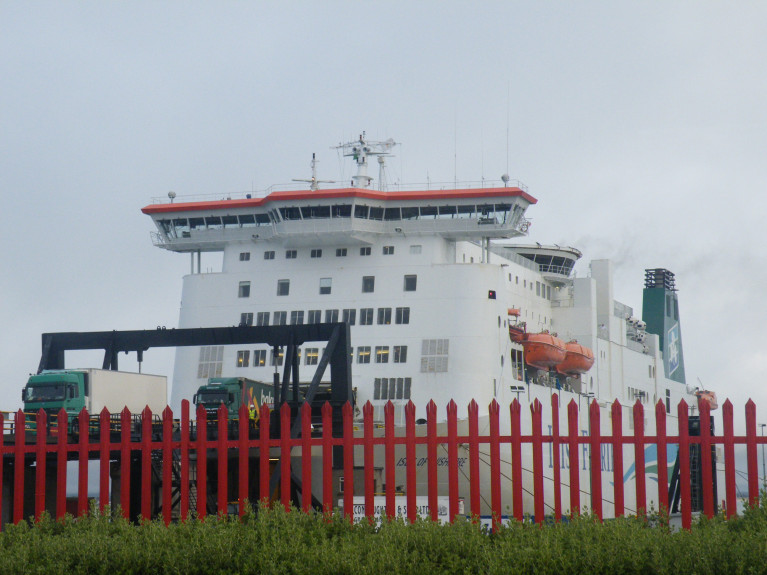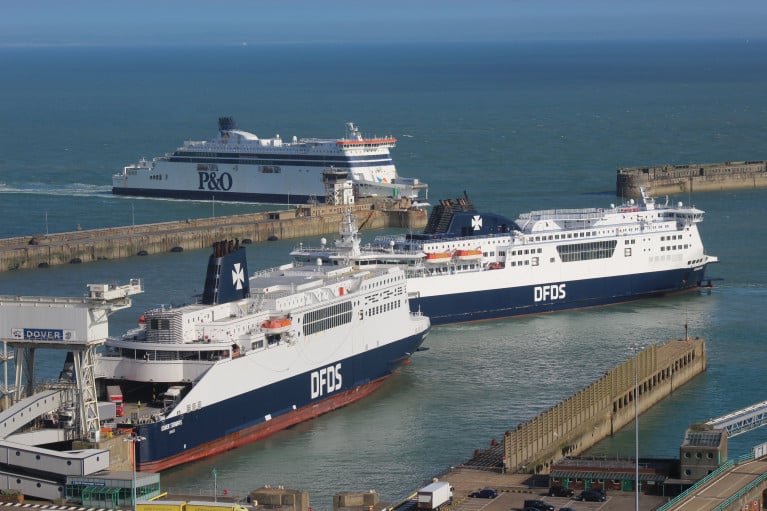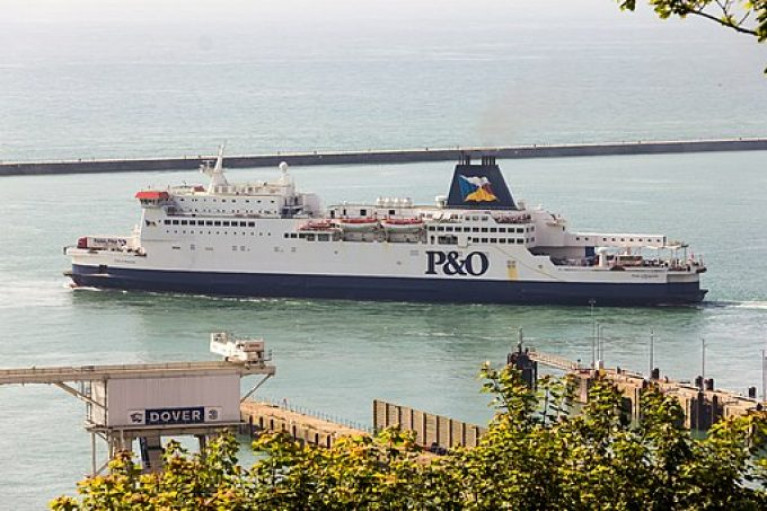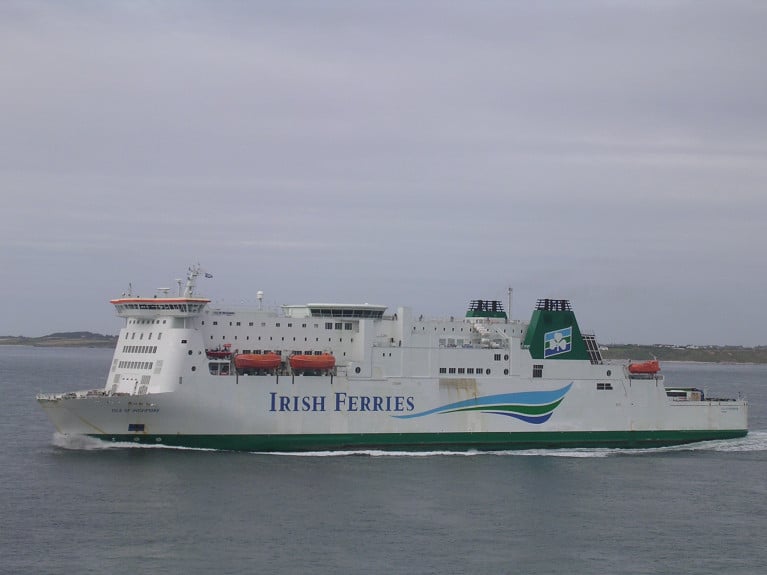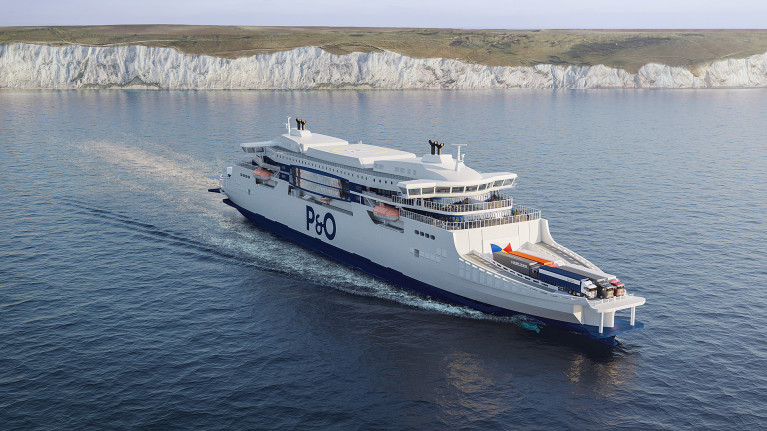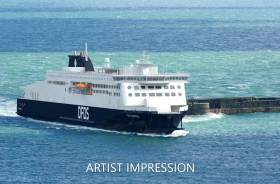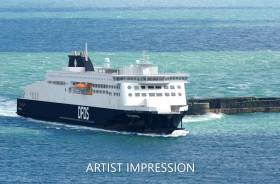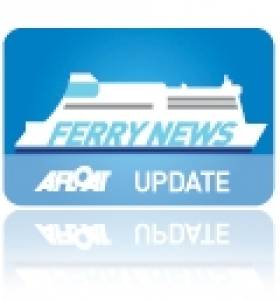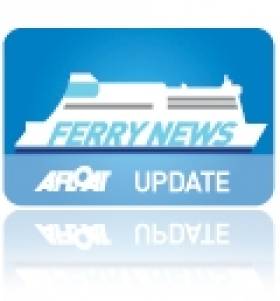Displaying items by tag: DoverCalais
English And French Unions to Fight Arrival of Irish Ferries New Service on Dover-Calais Route
UK and French unions claim the firm, Irish Ferries, which already operates Ireland-UK and Ireland-France routes, is aggressively low-cost and will seriously damage existing services and result in a lowering of standards.
Cross-Channel (Strait of Dover) ferry firms are hoping holiday travel will increase after a difficult year – especially if France is listed as ‘green’ in the UK’s traffic light travel scheme this month.
Irish Ferries’ website shows Britain-France options but no dates may yet be booked. It says the service will start in June with the transfer of the Isle of Inishmore. A second ferry is expected late this year and another in 2022.
The firm says it wants to “bring more choice to customers”. Freight lorries will be able to travel from Ireland through Wales and England, then via ferry to the Continent.
It says the level of passenger services will depend on the easing of Covid restrictions.
It is not known if foot passenger bookings will be offered.
Rival (see story) P&O has not yet resumed these and they are not offered by the other Dover-Calais operator, DFDS.
The chairman of Calais port, Jean-Marc Puissesseau, called the launch a “clear sign of confidence” in a year which also sees major infrastructure improvements at Calais.
Further reading, reports The Connexion.
Ferry rivals, DFDS & P&O have today entered into a mutual space charter agreement on the Dover-Calais route to shorten freight customers’ waiting times.
The new agreement according to DFDS on the premier short-sea route will also improve the flow of freight traffic across this vital arterial trade link between the UK and France and the rest of the EU member states.
Freight drivers will be able to board the next available sailing when they arrive at the Port of Dover or the Port of Calais, regardless of which of the two ferry companies is operating the crossing. This will ensure customers benefit from more flexibility, with a sailing every 36 minutes. It will reduce the amount of waiting time at the port saving our freight customers up to 30 minutes on their overall journey time.
Whilst the agreement means that capacity is shared, all commercial activities remain entirely under the control of each operator.
The new agreement is for freight vehicles only and does not apply to sailings on the Dover-Dunkirk route, which is solely operated by DFDS and will continue to provide a convenient alternative from Dover, with regular sailings and easy access to the Northern European road network.
Filip Hermann, Vice-President and Head of Channel Routes for DFDS, said: “Our focus is always to improve the ferry offering to freight customers. With this new space charter agreement in Dover-Calais we offer faster crossings and flexibility to relieve congestion and keep trade flowing”.
The two ferry companies carry more than 2.5 million lorries across the English Channel every year, making it the busiest trade route between the UK and Europe, maintaining the flow of essential items including food, medicines and other materials into and out of the UK.
As Afloat previously reported, operator, Irish Ferries next month is to launch a brand new service on Dover-Calais route with the transfer of Isle of Inishmore from Rosslare-Pembroke duties.
Initially, sailings on the UK-France link will be based only for freight customers, providing hauliers with an inclusive UK landbridge post-Brexit connection, as this also includes the operators main Irish Sea route of Dublin-Holyhead.
As Irish Ferries is to become a rival to P&O Ferries on the Dover-Calais market, the ferry firm is set to respond on the UK-France route by deploying a fifth vessel.
The DP World-owned company announced its ro-pax Pride of Burgundy vessel would return to the route in June.
It’s a service the vessel operated for the best part of 26 years before P&O Ferries reduced capacity in response to the pandemic and the cessation of cross-Channel passenger traffic.
More from The Loadstar here.
A first for Irish Ferries, as the subsidiary of Irish Continental Group plc (ICG) has announced a new service on the Dover – Calais route.
The service is planned to start in June 2021, with the transfer of Isle of Inishmore (see newer ship for Rosslare-Pembroke Dock route) to the UK-France route. Additional capacity will be added in the coming months.
Irish Ferries is the market leader for freight and passengers between Britain and the Republic of Ireland, a leadership position that has been built on the twin pillars of customer focus and investment in purpose built ships for each route. An Irish Ferries spokesman said:
We are very excited about launching our services on the best short sea ferry market in the world and we believe we can bring more choice for customers in the years ahead.
As part of our commitment to the movement of freight on and off the Island of Ireland to both the UK and Europe, this additional capacity on the Dover – Calais route will significantly strengthen the capacity and reliability of the landbridge for exporters and importers.
Hauliers will now have one operator providing an inclusive service on the Dublin - Holyhead, Rosslare - Pembroke and Dover - Calais routes. This will allow exporters and importers easier, cheaper, and quicker access to our European markets via the Common Transit Convention.
It is intended to offer passenger services on the route. The initial level of passenger services offered will be dependent on the easing of Covid-19 travel restrictions.
Doug Bannister, Chief Executive, Port of Dover, said: “We are delighted to welcome Irish Ferries to Dover. This announcement gives the millions of customers across the UK and the Republic of Ireland who value the intrinsic benefits of the shortest sea crossing to Europe, the prospect of even more choice. We believe the inclusive landbridge product will be popular with Irish exporters and will strengthen the just in time supply chain into the European Union. This is a clear signal of market confidence in the Dover route and will complement the resilient services currently provided. We wish Irish Ferries every success and look forward to having them on the route in the summer and working together as part of the Dover team building the future success of the Short Straits.”
Jean-Marc Puissesseau, Chairman, Port of Calais, said: “the commencement of the service operated by Irish Ferries emphasises the strategic position of the port of Calais in the trade between Ireland, the United Kingdom and the continent. It is a clear sign of confidence just a few weeks before the opening of the new port of Calais
New Ships for P&O Ferries Dover-Calais Route to Enter Service by 2023
Official images have been released of P&O Ferries €260 million new generation of super-ferries which will see the new tonnage transform the experience of travelling between Britain and mainland Europe.
The newbuilds will be the largest ferries ever to sail between Dover and Calais at 230m long and according to Multimodal.org.uk the first is to enter service by 2023.
David Stretch, Managing Director - Short Routes at P&O Ferries, said: “These remarkable images provide a glimpse of the transformation which our customers will experience when they travel between Britain and Europe on the most sustainable, most reliable and most customer friendly ships ever to sail on the route.
“This major investment will be a vital part of Europe’s transport infrastructure into the 2040s and symbolises our commitment to making trade flow for our customers.”
Major innovations of the new super-ferries will include:
- Cutting fuel use by 40 per cent through a combination of fuel and battery propulsion
- The heat recovery system saves fuel which reduces the vessel’s carbon footprint
- Future proofing anticipates the ‘zero carbon emissions ship’
- A double-ended design and two bridges on the ship, meaning that there is no need for it to turn around
- Outside deck areas to provide viewing platforms of the White Cliffs of Dover
- Panoramic sea views for passengers
- A power management system to efficiently close down parts of the ship when not in use
- A revolutionary new shape of hull for the English Channel and azimuth thrusters which increase manoeuvrability of the ship
Operator DFDS Announce Official Keel-Laying for Dover-Calais Newbuild, Cote D’Opale
Danish operator DFDS recently announced another milestone at the Avic Shipyard in Weihai, China, as the keel was officially laid on the new charter vessel, Cote D'Opale, the name which was previously reported on Afloat.ie
Owner of the newbuild Stena-E-Flexer class, Stena RoRo and DFDS will take the ferry on a 10 year bare-boat charter from delivery in China in June 2021.
Cote D'Opale will enter service on the Dover-Calais route, the busiest ferry-route between the UK and mainland Europe.
The new ferry will be the longest ship on the channel with capacity for 1,000 passengers and crew.
DFDS also operates passenger ferry services, Dover to Dunkirk, Newcastle to Amsterdam and Newhaven to Dieppe (see related story).
In addition to the UK routes, DFDS which is northern Europe’s largest integrated shipping and logistics company, they operate ferry routes in Scandinavia, the Baltic and an extensive freight-ferry network.
Danish Giant DFDS Announce Name of New English Channel Ferry for Dover Service in 2021
Danish shipping giant DFDS, has announced the name of their new ferry Côte D'Opale which is due for English Channel service between Dover and Calais in 2021.
The newbuild is named after a region of France that overlooks the English Channel. The Côte d'Opale is a French coastal region bordering Belgium, situated opposite the cliffs of the south-east of England.
Côte D'Opale yesterday started its journey with the first steel plates being cut in the traditional steel cutting ceremony. The vessel is being built at the AVIC shipyard in Weihai, China and will be launched for operation in 2021 on the Dover Calais route. It will be the longest ship on the channel with capacity for 1,000 passengers and crew.
The emphasis has been to provide customers with the best possible service and experience on board each and every day. Earlier this year DFDS put extensive investment into ensuring their ships are the best in meeting customer's needs, with investing in a substantial fleet renewal programme to ensure continued growth. Improving the customer experience with passenger comfort, children's play area, familiarity and dynamic food concepts at the forefront in the design process. Also offering WiFi, children's play area and easily accessible outdoor space.
Further development of the modern sea travel experience will be replicated over time across the fleet on the English Channel, which will bear a familiar resemblance to the Côte d'Opale. Further enhancing the best possible customer experience that DFDS has to offer, regardless of which vessel customers sail on.
Kasper Moos, Head of Short Routes and Passenger in DFDS said "We have great pleasure in announcing our new ship will be named the Cote D'Opale and the steel cutting marked a very special and exciting time as the ship starts to take shape in the construction process. The Côte D'Opale will give our passengers a relaxed travel experience with modern food concepts and the largest shopping experience on the channel. We continue to have a clear focus on our customers and take great pride in continually seeking improvements to ensure those special memorable experiences of travelling with DFDS.''
Eurotunnel Sells MyFerryLink Twins to DFDS
#DoverCalais – Lloyds Loading List reports that the Eurotunnel Group announced last week that it agreed to sell the main assets of its MyFerryLink maritime business, claiming that "the conditions necessary to develop freely did not exist".
Eurotunnel said it had received a binding offer from DFDS for a "let to buy sale" of two of its three ferries, Rodin and Berlioz. It added that it "regrets" that the SCOP SeaFrance workers co-operative that has operated the vessels since their purchase by Eurotunnel from SeaFrance "has not had the support it needed to be able to present a takeover proposal".
With regard to MyFerryLink's third vessel, Nord Pas de Calais, Eurotunnel said: "In order to maintain its transport operations, Eurotunnel Group will ask the competition authorities to lift the current prohibition and to enable it to be operated in coordination with the Fixed Link."
Eurotunnel said it believed the UK Competition and Markets Authority (CMA) "should not oppose" the completion of the sale of the two ferries, "which will lead to two maritime operators of equal importance".
With this sale, Eurotunnel said it would "ensure that the activity remains in Calais, a situation which was not achieved when the SeaFrance Moliere was sold by its owner, Le Credit Lyonnais, to be operated in the Irish Sea".
Afloat.ie adds that SeaFrance Moliere which spent a stint for DFDS also on the Dover-Calais service was introduced in March as Stena Superfast X on the Dublin Port-Holyhead route.
The newcomer directly replaced Stena Nordica which incidentally serves for DFDS on the premier UK-France short sea service as Malo Seaways.
For more on this ferry industry development, Lloyds Loading List has the full report here.
Time to Meet Mother Ship When Driving Hyprid On Holiday
#PlugInFerry - Within a decade, you could be driving to Dover for the summer getaway in a hybrid car — and when you get there to the continent, you could be boarding a plug-in electric ferry, so writes The Times.co.uk.
According to ABB, the European engineering giant, hybrid electric vessels are coming on stream and plug-in hybrid technology could begin to rule the waves.
Offshore supply ships and deep-sea drilling vessels in the oil and gas industry are already embracing the new technologies, according to Heikki Soljama, the managing director of ABB ports and marine. "There are similarities with the car industry, where in the foreseeable future we do not see.... to find out what more, visit the newspaper's link here.
Afloat adds that notably ferry followers in particular may recognise the profile of the ferry in photo accompanying the Times piece. The ferry in question is SeaFrance Moliere, alas the current Stena Superfast X.
She is seen here in a former guise in the Port of Dover when she served SeaFrance, the French operator that no longer exists, though her fleetmates remain in service for successor MyFerrylink.com.
This Dover-Calais operator is owned by Eurotunnel /SCOP that runs in the highly competitive premier UK-France short sea-service that is also served by P&O Ferries and DFDS Seaways.
The collapse of SeaFrance led to her eventual return to the same route albeit on charter to DFDS Seaways/LD Lines joint venture under the name Dieppe Seaways.
Stena had chartered the ferry to DFDS however this ceased in late 2014. This was followed as her Irish Sea entry as Stena Superfast X last month and directly replacing Stena Nordica.
As previously reported on Afloat.ie, DFDS are expected to launch the former 'Nordica' as their Malo Seaways on the Strait of Dover route.
UK Competition Commission Question Eurotunnel Ferry Deal
#FerryCompetition – English Channel passengers and freight customers could face increased prices following Eurotunnel's acquisition of ferry operator, SeaFrance (Dover-Calais) the Competition Commission (CC) has provisionally found.
According to a summary of the CC's provisional findings published today, by adding ferry services to its existing Channel Tunnel business, Eurotunnel would significantly increase its already high share of the cross-Channel market and prices would rise.
The CC also found that Eurotunnel decided to acquire the SeaFrance ferries in order to prevent ferry operator DFDS/LD from buying them. Eurotunnel was concerned that if DFDS/LD obtained the assets cheaply, it could drive down prices for customers. For more on this story, from the UK's Competition Commission, click HERE.


























